Balance of Threat: Iran’s Relations with the GCC States

The theory of “Balance of Threat,” introduced by Stephen Walt, rests on the principle that states balance not merely against the objective power of other actors in the international system, but against perceived threats. Such threats are shaped by four key components:
-
Aggregate power – including population, economic capacity, and military strength.
-
Geographic proximity – which increases the likelihood of confrontation and raises the costs of tension.
-
Offensive capabilities – encompassing operational ability for attack or coercion, including weapon systems, military technology, and cyber capacities.
-
Perceived offensive intentions – which do not necessarily align with a state’s actual intentions, but are inferred from behavior, rhetoric, and historical record.
In the geopolitical environment of the Persian Gulf, these four components operate simultaneously and with intensity, as actors’ perceptions of one another often outweigh objective realities. The region’s long history of tensions, identity-based and ideological rivalries, as well as interventions by extra-regional powers, have widened the gap between perceptions and facts—turning this gap itself into a security dilemma and fueling cycles of action and reaction.
From the standpoint of aggregate power, Iran—with its strategic depth, large population, regional influence networks, and significant missile and drone capabilities—has been able to generate a degree of regional deterrence. However, decades of economic sanctions, unstable growth, and limited access to foreign capital and technology have constrained Iran’s ability to fully develop its capabilities.
The GCC states—particularly Saudi Arabia and the UAE—enjoy advantages such as high financial capacity, access to advanced Western weaponry, and superiority in air and missile defense. Yet, their heavy dependence on foreign suppliers and their relatively small populations affect the durability of their power and deterrent capacity.
Geographic proximity, especially in the Strait of Hormuz and shared strategic waters, means that even limited tensions raise economic costs and maritime security risks for both sides. This closeness functions both as a natural deterrent and as a compelling reason to establish mechanisms for confidence-building and threat-reduction.
In terms of offensive capabilities, Iran emphasizes ballistic and cruise missiles, advanced drones, asymmetric naval warfare, layered deterrence, cyber tools, and regionally networked non-state actors. By contrast, the GCC states rely on air superiority, missile defense systems, advanced intelligence networks, and security partnerships with extra-regional actors such as the United States and, in some cases, Israel. This asymmetry in military instruments encourages each side to amplify its own strengths while exaggerating the vulnerabilities of the other—thus deepening the security dilemma.
Regarding perceived offensive intentions, some GCC members interpret Iran’s nuclear program, regional activities, and missile development as signs of expansionist ambition. Conversely, Iran views the large U.S. military presence, heavy arms purchases, and GCC–Israel security cooperation as containment or direct threats. Bridging the gap between perception and reality therefore requires transparent security dialogue and practical measures to reduce the weight of perceived offensive intentions and to build mutual trust.
Within this framework, the Balance of Threat theory helps explain diverse patterns of behavior:
-
External balancing: some GCC members rely on U.S. security guarantees to contain Iran.
-
Internal balancing: Iran and certain GCC states invest in defense and deterrence to enhance independent security.
-
Hedging policies: countries like Oman, Qatar, and Kuwait avoid full polarization, pursuing limited cooperation with regional powers while maintaining relative deterrence.
An analysis of Iran–GCC relations through the lens of the Balance of Threat theory shows that regional actors’ behavior is shaped more by perceived threats than by objective power. Geographic proximity, historical tensions, and divergent deterrence strategies have created a complex cycle of action and reaction, resulting in a regional security dilemma. Ultimately, the future of Persian Gulf relations will be shaped by these four components, and their effective management—through smart diplomacy and robust confidence-building mechanisms—will be the key to reducing tensions and enhancing stability in the Persian Gulf.






